Long-Term Projects - 3rd Prize
Trapped in Greece
Angelos Tzortzinis
Partially funded by the Magnum Foundation
Partially funded by the Magnum Foundation
24 August, 2020
Makeshift shelters cover a hillside outside the official refugee camp at Moria, Lesbos, Greece. As a result of overcrowding, the camp expanded into a nearby olive grove, which became known as the ‘Moria jungle’. Living quarters were largely makeshift, made from pallets and tarpaulins.
Tens of thousands of people fleeing war and poverty-stricken homelands have become stranded in Greece since the height of Europe’s refugee crisis in 2016. According to a UNHCR report in March 2016, more than one million people, mostly refugees from Syria, Iraq, and Afghanistan, had crossed into Greece since the start of 2015. As Balkan and European countries north of Greece began closing their borders to incoming migrants, more than 90,000 people were left trapped in Greece, in camps or on the streets. Moria Reception and Identification Center on the island of Lesbos, in the eastern Aegean, was the largest refugee camp in Europe, until it burned down in a fire in September 2020. By the summer of 2020, approximately 20,000 people were living in a camp built to accommodate 3,000. Residents complained of rain, cold, illness, lack of food and safety, unsanitary toilets, and water shortages.The fire, which broke out on 9 September, almost completely destroyed the camp. The Greek government said that the fires were started deliberately by migrants protesting that the camp had been put in lockdown as the result of a COVID-19 outbreak. On the nearby island of Samos, at the end of 2019, almost 8,000 refugees were living on a former military base that had been built to hold 650. Islanders held regular protests demanding the transfer of facilities to the mainland, and camp residents protested against their living conditions. On 2 November 2020, fire broke out in the camp, two days after the island was struck by a 6.7 magnitude earthquake. Between 100 and 150 people lost their homes.
The photographer has been working on migration issues for eight years. This project—shot on Samos and Lesbos, and in refugee camps around Greece—aims to explore human and social adaptability.

Angelos Tzortzinis
Angelos Tzortzinis is a Greek documentary photographer based in Athens. He graduated from the Leica Academy of Creative Photography in Athens and has been recognized wit...
Through our education programs, the World Press Photo Foundation encourages diverse accounts of the world that present stories with different perspectives.
Our exhibitions showcase stories that make people stop, feel, think and act to a worldwide audience.
Our annual contest recognizes and rewards the best in photojournalism and documentary photography.
